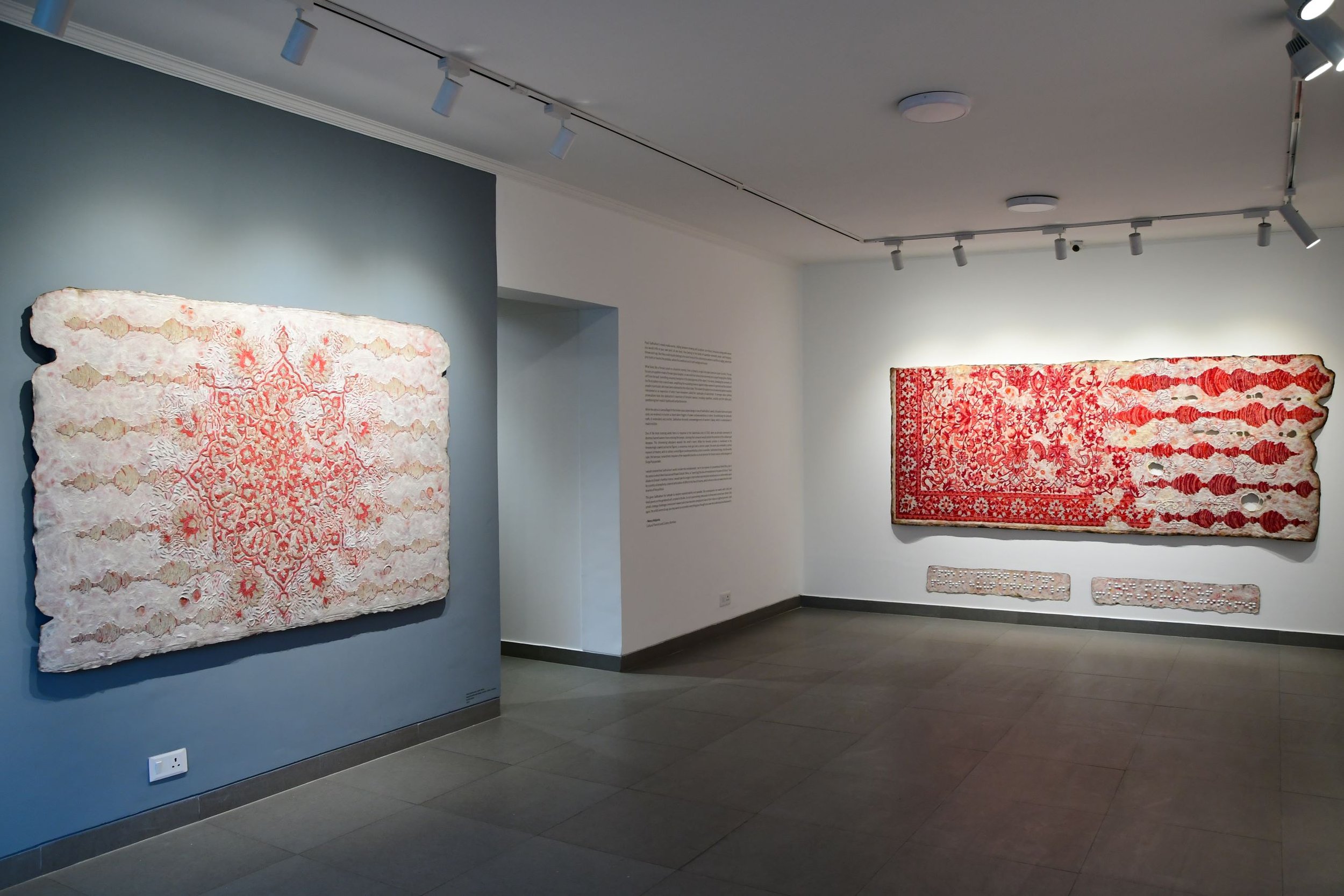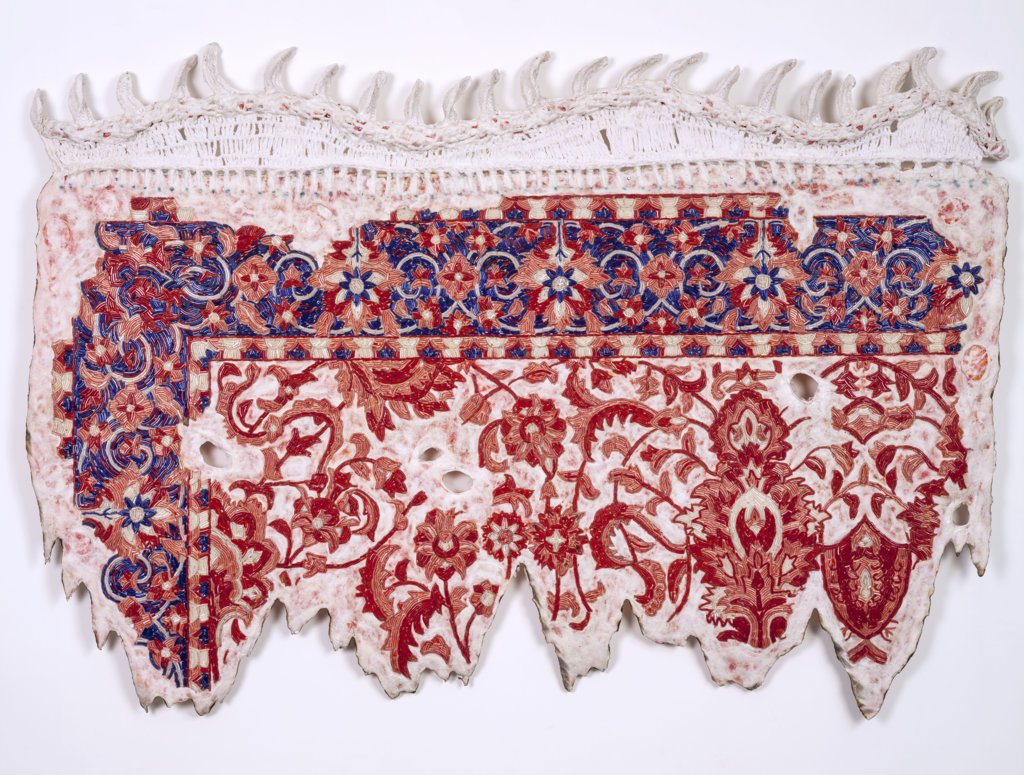
Seeing Is (Not) Believing by Piyali Sadhukhan
April 16, 2019 – May 31, 2019 at Akar Prakar, Delhi
Piyali Sadhukhan’s mixed-media works, sliding between drawing and sculpture, are robust, tenacious beings with whom you would trifle at your own peril. At one level, they belong to the family of quotidian domestic props: wall hangings, throws and rugs. But they could equally belong to the dark forest of the subconscious where a sacrifice is raging, where the prey hunts or haunts the predator, where the umbilical cord is both vestige and noose.
What looks like a Persian carpet or a Kashmiri namda, from a distance, erupts into open sores on closer scrutiny. The eye focuses on a pattern made of broken glass bangles; on wounds that refuse to be stemmed; on a carpet hanging like a flailing self from the wall. Something uncanny transpires in the physiognomy of this object. It screams, breaking the symmetry of the floral pattern into a sound wave, amplifying the escalating violence against Indian women in general and the Kashmiri people in particular, who have been colonized by the Indian state. This violent disruption in an ornamental pattern could be interpreted as an expression of what I have elsewhere called the ‘politicality of abstraction’. It emerges when political provocations hack into abstraction’s repertoire of formalist devices, including repetition, seriality and the stable grid, questioning their implicit rigidity and authoritarianism.
While the uterus is camouflaged in the broken-glass carpet design in one of Sadhukhan’s works, the pelvic bone and spinal cords are rendered in crochet as stand-alone triggers of power and woundedness in others. By politicising the domestic crafts of embroidery and crochet, Sadhukhan demands acknowledgement of women’s labour, which is undervalued or made invisible.
One of the most stunning works here is a response to the Sabarimala crisis of 2018, when an all-male community of devotees barred women from entering the temple, claiming their presence would pollute the precinct of the celibate god Ayyappa. This shimmering altarpiece exceeds the artist’s intent. While her feminist position is manifested in the threateningly cowled patriarchal figures, a censorious male god and a uterine carpet, this work also embodies a primal moment of theatre, with its solitary central figure counterpointed by a choric ensemble. Sadhukhan brings, into the white cube, the baroque, synaesthetic impulses of her expanded practice as an art director for theatre and an artist-designer of Durga Puja pandals.
I would contend that Sadhukhan’s works reclaim the melodramatic, not in the manner of conventional Hindi films, but in the sense in which Mani Kaul parsed Ritwik Ghatak’s films, as “open[ing] the idea of melodrama to the pain of history”. Kaul alludes to Ghatak’s Partition history. I would take his insight a step further and interpret melodrama as an alternative space for a poetics of polyphony, a layered articulation of affect in the face of trauma, which refuses to be narrowed into the stark binaries of the political.
This gives Sadhukhan the latitude to explore unpredictability and paradox. She accompanies her works with Urdu and Hindi poems on the gendered self, scripted in Braille. It is not a patronising concession to those who cannot see. Rather, this artistic strategy challenges omniscient viewers who have become complacent about their status as sighted persons. Look again, the artist seems to say, you may want to reconsider everything you thought you saw and understood and believed in.
Nancy Adajania, Cultural Theorist and Curator, Bombay
Piyali Sadhukhan’s new oeuvre turns to the individual, the single, as she moves toward intangible, weathered imaginations of form. The residues of everyday life, in flesh tints with suggestions of bleached bone, emerge time and again in her work, in response to her question – Where are we? Where am I? From order to dispersal and back again, from the folding spinal shapes that fold into itself, these frames of understanding underline the fragile and demanding nature of the body and its travails.
Communicating seamlessly in a visual world, the blind continually negotiate the materiality of multisensory perception in a way that demands relooking at ‘implanted visions’ of the human situation. Consciousness cannot be known separately from materiality, feeling and perception, and Piyali Sadhukhan’s works draw upon layers of memory, knowledge and meaning to provoke awareness of agency and subjectivity. In a way it mirrors the experiential instinct of the sightless, reading the materiality of the world in a different way, through the aggregates of experience.
Coming closer to the everyday, Piyali’s work uses found everyday objects, with materials ranging from glass bangles to antiseptic gauze. Converging repeatedly, these works create a spatial, intangible kantha (or embroidery of thrift), that articulates a uniquely crafted telling of experience. Behind muted colours and complex shapes, she places people and their stories in the lead, describing their strength in holding up as well as the fragility of falling apart. From experiences shared, her creations evoke empathy, and plunging into the pain of lives broken in ways expected and unexpected, draw attention to the effect of small actions by which women reduce the pain of their lives. These works make it seem possible that the broken will find its place in a whole, just as inevitably, creation follows destruction.
Reflecting on violence, especially in its gendered dimension, Piyali recognises how violence and politics is played out on women's bodies, and the experience of pain is widespread and recognisable. From larger than life skeletal structures or through painstakingly arranged patterns of colored glass, these works call us to fill them with meaning, to take away what we can. From this perspective, art is a place where anything may be revealed, including the negative entropy (or disequilibrium) of anger, grief and emptiness we once thought it (just as human beings) should transcend.
Surajit Sarkar, Associate Professor and Coordinator of the Centre for Community Knowledge at Ambedkar University, Delhi
Piyali Sadhukhan | She broke her spine in a stumble down an alpine pass | Galvanized wire, cotton, Nepali handmade paper, bangles, Acrylic yarn | Size variable | 2019
Piyali Sadhukhan | Flaming Altar | Nepali handmade paper, canvas, cotton, fabric, bangles, acrylic paint, iron structure | 105 x 107 in (Wall pc), 59 x 119 in (Carpet) | 2019
Piyali Sadhukhan | Reliever | Nepali handmade paper, canvas, cotton fabric, bangles, acrylic paint | 65 x 45.5 in | 2019
Piyali Sadhukhan | Silent Automata | Code White | Nepali handmade paper, canvas, cotton, bangles, acrylic paint | 80 x 52 in | 2019
Piyali Sadhukhan | Silent Automata | Code Red | Nepali handmade paper, canvas, cotton, fabric, bangles, acrylic paint | 120 x 50 in | 2019
Piyali Sadhukhan | Spines | Acrylic yarn white adhesive | 27 x 3.25 in | 2019
Piyali Sadhukhan | Spines | Acrylic yarn white adhesive | 20.25 x 7 in | 2019
Piyali Sadhukhan | Spines | Acrylic yarn white adhesive | 14 x 12 in | 2019
Piyali Sadhukhan | Spines | Acrylic yarn white adhesive | 26.5 x 8 in | 2019
Piyali Sadhukhan | Spines | Acrylic yarn white adhesive | 19 x 7 in | 2019
Piyali Sadhukhan | Spines (set of 6) | Wool | 21.25 x 7 in | 2019
Piyali Sadhukhan | Silent Automata | Code Flight | Nepali handmade paper, cotton, cotton fabric, cotton yarn, ceramic, acrylic paint, acrylic yarn | 27 x 41 in Display size | 2019
Piyali Sadhukhan | Ebb | Nepali handmade paper, cotton, cotton fabric, cotton yarn, ceramic, acrylic paint, acrylic yarn, galvanized wire, cotton, white adhesive, acrylic yarn, acrylic color | 12 x 49 x 49 in (Circle), 15 x 16 in (Wall pc) | 2019
Piyali Sadhukhan | Blooming amnesia | Acrylic yarn, acrylic, white adhesive, iron structure | 12 x 12 x 7 in | 2019
Piyali Sadhukhan | Screaming silence | Acrylic yarn, cotton yarn, cotton, Nepali handmade paper, ceramic | 20 x 18 x 10 in | 2019
About Piyali Sadhukhan
Piyali Sadhukhan (b.1979) completed her MFA from Kala Bhavana, Visva Bharati University, in 2006. Soon afterward, she received a Junior Research Fellowship from the Government of India (2007-2008). Piyali’s engagement with layers of memory, knowledge and meaning takes her nearer to found objects and economical raw materials that are used every day. Her new oeuvre turns to the individual, as she moves toward the intangible, weathered imaginations of form. She has participated in various projects including “Designs on Delta- exploring the making of myths”, a workshop based installation project by Khoj Kolkata(2012), the “Boat project installation” by Khoj Kolkata(2010) and “Logged” organized by Emami Chisel Art. She has also participated in many group shows. Her analytical essay, “Surveillance on Humanity”, was published in Art Etc, an art magazine by Emami Chisel Art.Over the last 12 years, she has acquired an experience as an artistic director and scenographer owing to her engagement with more than 85 Theatre productions. Her chief shows include, “Urban Narratives – a show at Espace Louis Vuitton,” Tokyo in 2012 (works funded by Louis Vuitton), “MODER KONO DESH NAI, MODER KONO DISHA NAI,” at Forum Schlossplutz, Switzerland in 2015, “Boitakkhana project”, at the residence of Prof. R.C. Majumdar, a workshop based installation project, an initiative by Khoj Kolkata (2014), 35th anniversary celebration show organized by Gorky Sadan (2009), “Entourage De Color,” Birla Academy (2008). Sponsored by Akar Prakar Gallery, Piyali had also made headlines with her 25x10x10ft Kaliya installation (a giant 3D installation) on the Indian museum courtyard in 2014.
About Nancy Adajania
Nancy Adajania is a cultural theorist and curator based in Bombay. Since the late-1990s, she has written consistently on the practices of four generations of Indian women artists and has proposed several theoretical models on transculturality, the biennial culture, public art, new media art and subaltern art. She recently curated Navjot’s retrospective ‘ “The Earth’s Heart Torn Out” – Navjot Altaf: A Life in Art’ at the NGMA Bombay (12 December 2018 – 25 January 2019) and ‘In the Land Of Downside Up: Adbhut Lok’ at the Birla Academy, Calcutta (9 January – 9 February 2019). She is currently working on the forthcoming retrospective of Sudhir Patwardhan at the NGMA, Bombay.


















